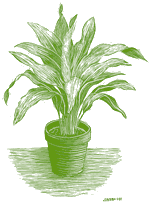Aspidistra—An Alluring and Enduring Favorite

My first encounter with an aspidistra was an aural, not a visual one. It was an Appell family radio moment. We were listening to an archival recording of the legendary English singer Gracie Fields performing the tune that became her signature hit: "The Biggest Aspidistra in the World." She broke off the first syllable of "aspidistra" with such comic expertise that my parents were immediately roaring with laughter. When I asked my father what all the fuss was about, he replied, "Some kind of plant." Mmm?
Years later, in 1970, Thalassa Cruso (my first horticultural mentor), published her ground-breaking indoor gardening book Making Things Grow. Unlike Ms. Fields, she spoke of aspidistra with almost mythic reverence, remembering how an elderly cousin called her inside one day for a special treat, "which proved to be something I have not often seen since: an aspidistra plant blooming away at soil level!"
I finally encountered my first real aspidistra plant in the "old" Conservatory at the Brooklyn Botanic Garden. It was suitably tropical looking, with large, glossy green, basally produced (i.e. from the plant base), lanceolate (meaning "lance-shaped") leaves—about 16 inches long by roughly 5 wide. The foliage had very long petioles (leaf stalks)—about a third of the leaf length. I thought it was very handsome. I poked around the base of the plant, looking for those mysterious ground-level flowers Thalassa had mentioned. There weren't any. I knew immediately, however, that I had to own one.
A Hardy Character
Aspidistra is native to eastern Asia, having adapted to a diversity of landscapes all the way from the lower Himalayas, through China, to the islands of Japan.
It can endure temperatures as low as 23 degrees Fahrenheit and—with good air circulation—as high as 100 degrees Fahrenheit. This is great news for houseplant lovers who dwell in those minimally air-conditioned, dismally insulated, or infernally over-heated apartments typical, at least, of New York City.
Aspidistra can survive extreme levels of urban pollution and dust, as well as light levels as low as 25 footcandles (although they prefer 75 footcandles or more—an unobstructed northern exposure, for example). Finally, as if attuned to the contingencies of modern living, they are forgiving of our inauspicious watering habits.
But this hardy (and hearty!) plant is much more than a best bet for indoor gardening dummies. Its foliage is a favorite component of Japanese Ikebana arrangements. Gardeners living in USDA Zone 10 and 11 grow aspidistra quite effectively outdoors as a tall, groundcover plant. And while traveling through Tuscany, I found it in huge Della Robbia terra-cotta pots, being used as a permanent outdoor feature.
The aspidistra reached England in 1822, where it became one of the most relied-upon Victorian parlor garden and conservatory plants. Every nineteenth-century home there had the ubiquitous cachepot of aspidistra lurking in a darkened corner. The Oxford English Dictionary remarks:
"[The aspidistra] is regarded as a symbol of full middle class respectability." But the plant's popularity declined around the time of The Great War—which just happened to be when Gracie Field's famous song appeared.
By virtue of its exonerating nature, and its tough-as-nails deportment, the aspidistra has earned itself a rather sundry list of common names: cast-iron plant, barbershop plant, barroom plant, and—most vivid—spittoon plant. It belongs to the Liliaceae (a family which includes lilies, hostas, tulips, and asparagus) and the subfamily Convallariaceae (which includes lily-of-the-valley and Solomon's seal). The etymology of the botanical name Aspidistra elatior (the most common species of aspidistra) is interesting. The genus name is extracted from the Latinized Greek word aspidion—"a small round shield"—possibly an allusion to the shape of the stigma (the pollen-receptive tip of the female part of a flower). The species name is drawn from a participle conjugation of the Latin effero "to raise, or elate"—which is subsequently interpreted as "taller." So, "taller shield?" Some kind of botanical allegory, no doubt.
Aspidistra How-to
The most discouraging aspect to aspidistras is their frustratingly slow rate of growth. They can take many years to achieve an appreciable size. But they do last. Evidence exists in Victorian family records of aspidistras being passed down from generation to generation—some over the period of a century! I have a 20-year-old plant, bearing about 35 leaves, that has (ever-so-slowly) increased in size from a nursery-purchased, two-leafed division.
I'm happy to report that it does occasionally bloom. The smallish flowers are tulip-like, puce in color, with darker speckling, and borne at soil level. If pollinated—a job that botanists believe is accomplished in the wild by slugs and snails—each flower would produce a single berry, similar to those of lily-of-the-valley.
Although aspidistras can be grown from seed, the usual method of propagation is via division. The underground, rhizomatous creeping rootstock is easily divisible with the aid of a stout kitchen knife. Keep three or four leaves per portion for a strong plantlet. Aspidistras cannot be propagated from leaf cuttings.
Aspidistras are relatively pest- and disease-free. However, due to their exceedingly slow rate of growth, they occasionally are susceptible to anthracnose or fungal leaf spots, which can be aggravated by perpetual over-watering. Simply prune away the affected foliage, sterilizing the cutting surface of the pruners with rubbing alcohol between each cut.
The most pernicious threat—particularly in diabolically heated apartments—is the spider mite. Use insecticidal soap, weekly cold showers (i.e. for the plants), and better air circulation to help eradicate them. If you have a large indoor garden, you can release predatory Phytoseiulus mites procured from mail-order suppliers of beneficial insects.
With new generations of Neo-Victorian indoor gardeners exploring plant selection, the aspidistra is, once again, back in vogue as an unparalleled choice. Enduring and alluring, it belongs in all of our homes, for at least another hundred years.
Nursery Sources:
Logee's Greenhouses141 North Street
Danielson, CT 06239-1939
(860) 774-8038 Glasshouse Works
Church Street, P.O. Box 97
Stewart, OH 54778-0097
(740) 662-2142
www.rareplants.com


